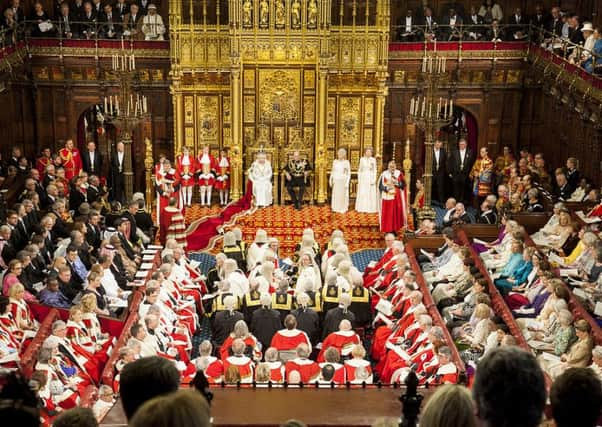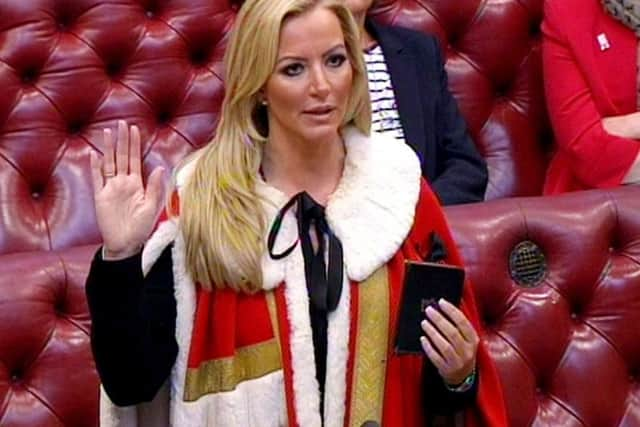The Scottish peers, who they are, why they are there - and what they do


For hundreds of years the House of Lords has courted criticism and controversy, most recently accused of “constitutional outrage” after voting against a Commons decision to cut tax credits. It was a decision that illuminated the full power of the second chamber whose function is all too often misted in privilege, pageantry and deep scepticism of the house which is still wholly unelected by the public.
A look through the most recent list of expenses claimed by members of the House of Lords shows there are 61 peers who are registered to live in Scotland.
Advertisement
Hide AdAdvertisement
Hide AdThis represents around eight per cent of the 760 eligible members of the House of Lords but does not include a significant number of others who have significant Scottish interests.


For example, some who have claim to ancient Scottish land titles but live in England are not included in the list of 61.
The Countess of Mar - who has claim to the oldest earldom in the UK - is amongst them.
Her family line is embedded deep in Deeside and Kincardine but the Countess lives on a farm in Worcestershire and is a successful goats cheese maker.
The Countess - who is a Deputy Speaker of the house- is also chief of Clan Mar.
Meanwhile, the 61 peers of Scotland do not include Baroness Mone, the lingerie tycoon, who left Glasgow for London following the referendum and who declined the offer of a territorial designation linked to her country of birth.
While she is officially just known as Baroness Mone, her “peerage postmark” is, with her agreement, Mayfair.
By contrast, a high number of non-hereditary peers have chosen a Scottish title to reflect their roots, despite their life and professional achievements having been largely forged outwith Scotland. Lord Lamont of Lerwick, the former Conservative chancellor, is one.
WHO ARE THE 61?
Elected hereditary peers
Advertisement
Hide AdAdvertisement
Hide AdOf the 61 peers listed as living in Scotland, 12 of them are elected hereditary peers. After reforms led by ‘Lords abolitionist’ Tony Blair in 1999, the number of hereditary peers admitted into the House was limited to 92. They no longer automatically get a seat on the red benches due to their birth line and are elected by political groupings of other hereditary peers, including cross-benchers.
Those who were voted in by fellow peers following the reforms include James Graham, 8th Duke of Montrose, a former Conservative shadow minister for the Scotland Office and a major landowner in the Drymen area. Mugdock Castle was earlier sold off by the family.
Lord Lyell, 76 who is registered as living in Angus, was another hereditary peer elected back in following reforms.
He is a director of a chauffeur driven cars firm and a shareholder and fan of Everton Football Club.
A number of hereditary peers knocked out of the Lords following reforms have since rejoined the second chamber after being voting in as a life peer by a political party.
James Erskine, Earl of Mar and Kellie, joined the red benches in 1994 following the death of his father but left the house following Blair’s reforms in 1999.
However, he was created a life peer by the Liberal Democrats in 2000 and took the title Baron Erkine of Alloa Tower, of Alloa in the County of Clackmannanshire. He unsuccessfully stood for the party in Ochil in the 1999 Scottish Parliamentary elections.
Lord Stair, whose mother is cousin to The Queen, rejoined the red benches in 2011 as an elected crossbencher.
Advertisement
Hide AdAdvertisement
Hide AdOther hereditary peers from Scotland serving in the House of Lords include Fife-based James Lindesay-Bethune, the Earl of Lindsay, and Alexander Scrymgeour, the Earl of Dundee, and the Earl of Kinnoul.
Thomas Galloway Dunlop du Roy de Blicquy Galbraith, 2nd Baron Strathclyde, served as the Leader of the House of Lords from May 2010 to January 2013. He is the son of former Hillhead MP Sir Tam Galbraith, who died in 1982, and he succeeded the Barony from his grandfather in 1985.
High ranking judicial figures
There are five former Lord Advocates serving on the red benches.
Colin Boyd - now Lord Boyd of Duncansby - was made a crossbench peer by Downing Street in 2006 while he was still Scotland’s top prosecutor. Concerns were raised over politicising the role and Boyd - who had been nominated by former First Minister Jack McConnell - announced his resignation as Lord Advocate and took the Labour whip.
McConnnell - now Lord McConnell of Glenscorrodale - was questioned by the Metropolitan Police in relation to his nomination of the former Lord Advocate as part of the Cash for Peerages investigation but no wrongdoing was found.
Other former Lord Advocates on the red benches include 88-year-old Lord Mackay of Clashfern. The record of the former Lord High Commissioner of the General Assembly of Scotland - and strict Sabattarian - suggests he is still very much active. In March he attended the House of Lords nine days out of a possible 17.
Life Peers
There are more than 40 life peers from Scotland now sitting in the House of Lords. drawn fro a range of political and professional interests. Most recent additions include former Liberal Democrat leader Menzies Campbell his party colleague Sir Malcolm Bruce and former Labour chancellor Alistair Darling.
He will become the 20th Labour peer from Scotland, with the party having the highest proportion of Scottish life peers.
Advertisement
Hide AdAdvertisement
Hide AdOther Labour figures who have been awarded a life peerage by the party include former Secretary of State for Scotland Des Browne, now known as Lord Browne of Ladyton; Baroness Lidell of Coatdyke, former secretary of state for Scotland and former First Minister of Scotland, Lord McConnell of Glencorrodale.
RECENT CONTROVERSIES
Lord Sewel, formerly a Labour peer and ally of former Prime Minister Tony Blair, resigned in July after being caught on video apparently sniffing cocaine and telling prostitutes he wanted to “be led astray”. Police took no further action against the peer, who lives with his family in Banchory.
Former Paisley MP Baroness Adams of Craigielea, said she would go to court to challenge an order to pay back £4,110 she had claimed for mortgage interest payments.
The sum was eventually written off by The Commons Commission in 2012 with the politician claiming her named had been blackened by the matter.
In 2009, four Labour peers, including former Kirkcaldy MP Lord Moonie, were drawn into a sting by undercover Sunday Times reporters.
Lord Moonie was later cleared of breaching the House of Lords code of conduct over allegations he and three others offered to amend legislatioon for up to £120,000/ Two other Labour peers left the house.
HOW MUCH DO THEY COST
According to the latest House of Lords Annual Report, net operating costs for the chamber totalled £94.4m for 2014/15.
Of this, £20.7m was spent on members’ allowances and expenses.
Advertisement
Hide AdAdvertisement
Hide AdThere are ongoing claims that peers are claiming hundreds of pounds a day simply by walking to the House of Lords and “signing in” to claim their daily allowance of £300.
DOES IT NEED FURTHER REFORM?
Wille Sullivan, director of Electoral Reform Society in Scotland, said a modern democray needed “effective rising chamber”.
However, he said the recent tax credit revolt proved the government was not interested in chamber of effective scrutineers.
Mr Sullivan said: “We’ve seen that when our unreformed House of Lords challenges the government, Ministers cry ‘constitutional crisis’. Voting down the government on tax credits has led to a ‘review’ of the powers of the upper house in order to limit it. It seems the government want rubber-stampers in robes rather than effective scrutineers. What will happen the next time the Lords does something that annoys the Prime Minister?
He said that a directly elected second chambers could “stick to its guns” and that the current set-up was a recipe for “constitutional turmoil.”
Mr Sullivan added: “Rather than jumping from one review to another every time the government loses a vote, a democratically-elected second chamber could stick to its guns. Instead, the current set-up is a recipe for constitutional turmoil.”
He described the Lords as the largest fully-unelected chamber in Europe and the second largest legislature in the world, after China.
The SNP has repeatedly called for the House of Lords to be scrapped.
THE VIEW OF A PEER
Advertisement
Hide AdAdvertisement
Hide AdMenzies Campbell, former Liberal Democrat leader and now Lord Campbell of Pitenweem, is one of the newest members of the second chambers.
He agreed further reform was necessary and that the house would unlikely survive in its present form.
The peer, who was sworn in just last week, said; “Those who come from the Commons bear garden sometimes find it difficult to adjust to the House of Lords.
“This is generally politics from another perspective and another age. Argument is intelligent and rational. It can hardly be described as adversarial. But will it survive in its present form? I very much doubt that it will.”
He said it was now widely agreed on all sides that the House of Lords is “too large”
The peer added: “Reform is inevitable.
“The furore about tax credits two weeks ago will hasten that reform. My own view remains that it requires to be reformed and it requires to be mainly elected to eighty per cent but with provision for those who might bring specialist knowledge to its deliberations to make up the remainder.
“But it would be a very different place. It is hard to see how its courtesy would survive accountability and adversarial politics.”